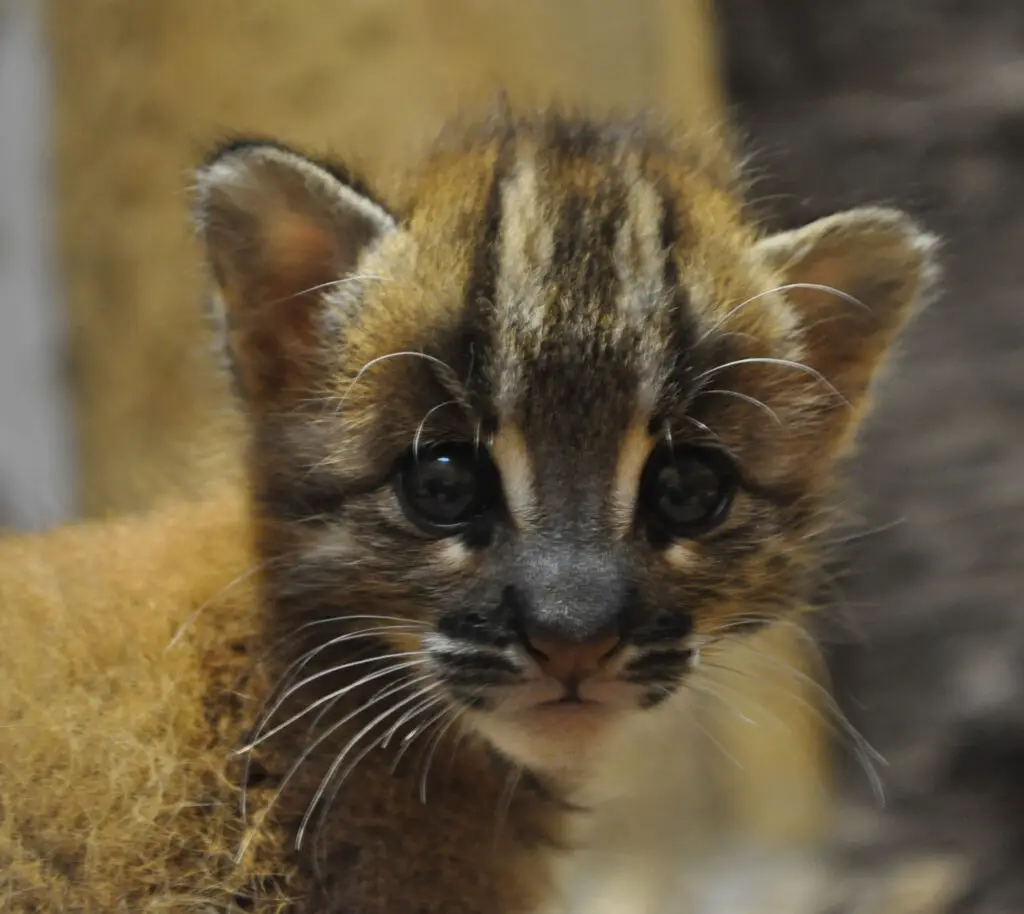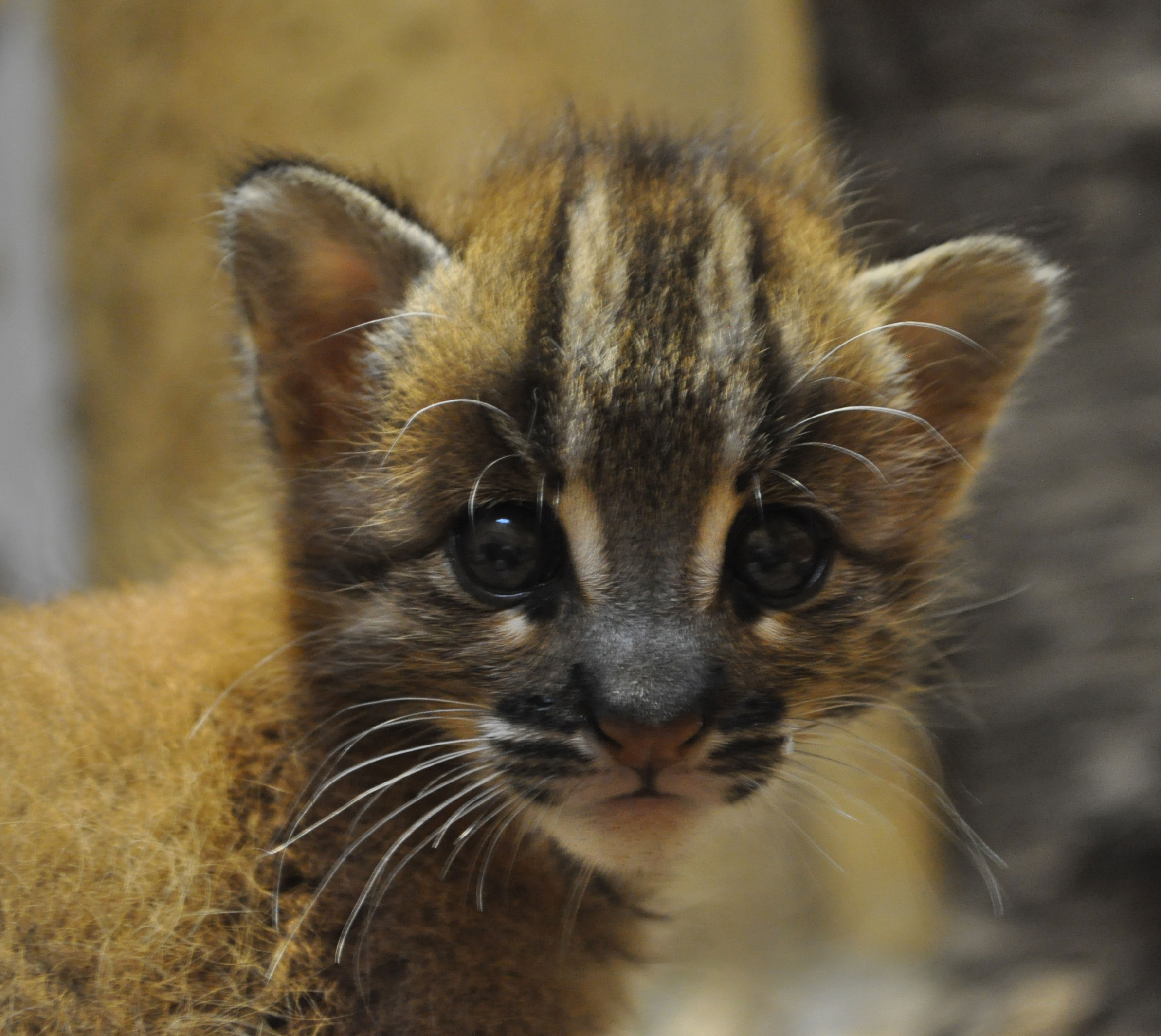By Becky Crew of Scientific american
A pair of Asiatic golden cats have been bred using artificial insemination for the first time in an effort to ensure the future of this rare and beautiful species.
Asiatic golden cats (Pardofelis temminckii) are small, nocturnal cats that live in the tropical rainforests of southeast Asia, their range stretching from China, Nepal and India to Burma, Thailand and Malaysia. They’re about two or three times the size of a house cat, the females growing to around 66 cm long (minus the tail) and 9 kg in weight, and the males are much larger at 105 cm long and 16 kg. They are shy animals that live solitary lives, fiercely maintaining large territories and only coming together briefly to mate.
The most common colouring of an Asiatic golden cat is a golden brown or fox-red, but they can also be a dark brown, grey or pale cinnamon. There is also a spotted, ocelot-like morph that is more common in China than the usual colouring, and numerous melanistic, or black, individuals have been found, particularly in Nepal. There’s even a tiny area in Sikkim, which is a small mountainous state in the Eastern Himalayan region, where melanistic Asiatic golden cats are far more common than any other morph.

Asian Golden Kitten
The golden coat of an adult Asiatic golden cat. Credit: Karen Stout; Flickr
Because of their striking colour, in some parts of Thailand Asiatic golden cats are called “Seua fai”, meaning ‘fire tiger’, and local legend states that the burning of its fur or the eating of its flesh can drive tigers away. The Karen people of Thailand and Burma believe that carrying a single Asiatic golden cat hair will have the same effect.
Habitat destruction and a relentless fur trade over the past few decades has seen the global population of the Asiatic golden cat dwindle to the point where we don’t know how many are left in the wild, and there are just 51 individuals in captivity in Europe and Asia. Captive breeding programs are essential to the survival of the species, but because we still know very little about their reproductive biology, and because they can be extremely aggressive towards each other, breeding them can be a very difficult and dangerous exercise, all the way from courtship to birth.
A 1997 study in the International Zoo Yearbook by zoo keeper Mike Brocklehurst from the Royal Melbourne Zoological Gardens describes the extraordinary measures the zoo’s staff had to go through to breed their Asiatic golden cats, even with almost 30 years of experience. Since 1968, when the Melbourne Zoo acquired their first five Asiatic golden cats from Europe and the US, they’ve had two deaths because of male on male and female on female fights; one death during a male and female introduction; and another within an established mating pair. Brocklehurst also reports two instances of a male killing a young female after copulation, and while it never happened at Melbourne Zoo, adult males and females have also been known to cannibalise their own young. So breeding Asiatic golden cats the ‘natural’ way is never as simple as sticking two of them in a room together and hoping they get along.
According to Brocklehurst, their breeding process began with keeping a male and female in adjacent enclosures for 30 days, allowing them to see, smell and hear each other. Feeding was increased by 20% during this time to make them less aggressive. Then, a door is opened, allowing the pair to interact physically for just an hour a day, this period increasing over two weeks if there are no signs of aggression. If all is well, 24-hour access is finally allowed, and they have 70 days to mate before they are separated once again. This is ensure that the male doesn’t go on a killing spree if the female gives birth. If the female does not give birth after 90 days, the whole process begins again. If she does give birth, she’ll likely only have one cub.
More recently, staff at the Allwetter Zoo in Münster, Germany, were also having problems with their Asiatic golden cat breeding pair – ‘Lao’ the male and ‘Sua Fai’ the female. Lao had attacked Sua Fai, and they were worried that the next attack could be fatal. While they were unable to find another suitable mate for Sua Fai, the team was reluctant to remove such a young female from the limited breeding program, so considered breeding the pair through artificial insemination. Knowing that no one had successfully bred this species using artificial insemination before, they came up with different methods to complete the process without surgery, and relied on Sua Fai’s natural estrous cycle rather than a pre-treatment hormone program. The project was led by veterinarian Imke Lüders, a specialist in assisted reproduction techniques for zoo animals. “I had just tested a new semen collection method in lions and cheetahs in South Africa,” she says. “I think this was one of the key factors for a successful artificial insemination. Lions and cheetahs are much bigger,
Because they had decided not to use a pre-treatment hormone program, the zoo staff had to observe Sua Fai closely to pick when she was in heat, which was their cue to extract the semen from Lao. In many animals, the semen required for artificial insemination is usually collected via electro ejaculation – placing electrodes into the rectum to stimulate the prostate and produce an ejaculation. But this method causes urine contamination of the sample, plus high volumes of seminal plasma, which can reduce the chances of pregnancy. So instead, Lüders’s team anesthetized Lao, causing semen to be released into the urethra, and performed and enema and transrectal ultrasound scan to visualise the prostate. They then used a urinary catheter to collect a highly concentrated, uncontaminated semen sample. The female Sua Fai was anesthetized and given a dose of hormones to induce ovulation – which only worked because the zoo staff had correctly identified that she was in heat – and the semen was inserted into her uterus. After a period of about 80 days, Sua Fai gave birth to two cubs, a male and a female, on April 7.
“Usually, Asiatic golden cats give birth to one cub, but we had twins!” says Lüders. ”However, after initial intensive maternal care, Sua Fai changed her nesting box and left one cub [the female] behind. We were very happy that she showed such a good maternal instinct in the beginning – it is not unusual that first-time mothers do not take care of their babies at all, or even eat them.”
To ensure that Sua Fai didn’t stress out and neglect her other cub, the Allwetter Zoo staff removed the female cub she left behind. “While Sua Fai is still a perfect mom to the male cub, the female was hand-raised,” says Lüders. “Both cubs are doing fine! We even place the little female back to socialise with her brother when their mum is outside. They play a lot together. I really hope they both make it, and will bring new hope for the breeding program.”
Lüders now plans to help another European zoo breed their Asiatic golden cats using this new technique, and while it may help in situations similar to Lao and Sua Fai’s, she does not think it will take the place of breeding the cats naturally. “We need to focus on their social behaviour, and on creating harmonic breeding pairs. Maybe by introducing the partners much earlier in their life. But in our case, I am still very glad we did it. It is such a great thing for the cat to raise a baby – no better enrichment possible for a captive female.”
“These cats may adapt to a variety of habitats, but they need undisturbed, intact areas in order to find prey and raise their young,” she added. “This is becoming more and more scarce in Asia. As for so many other wildlife, the chances of survival are small. For the Asiatic golden cat, I hope their size may help them to survive longer and under more severe conditions, but it is hard to predict. We do not even know how many are still out there.”
Head over to Zooborns to see more photos of how incredibly gorgeous the twins are at seven weeks old!
